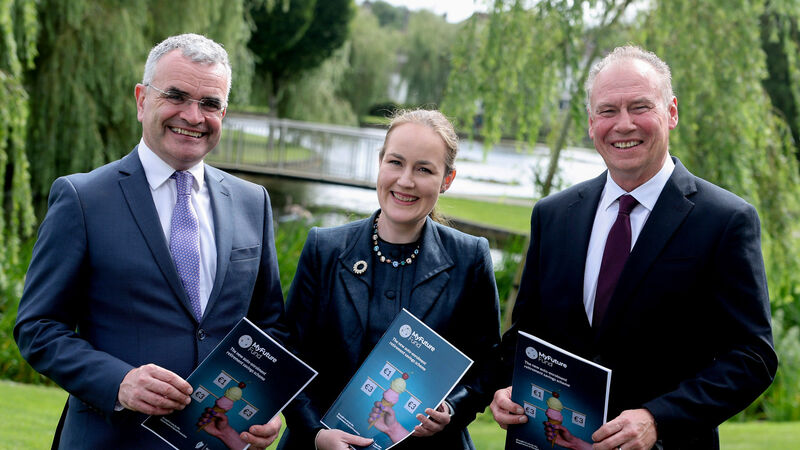Understanding ‘MyFutureFund’ – Ireland’s new auto-enrolment retirement savings system

Minister for Social Protection, Dara Calleary, TD, with Roma Burke, the first chair of the board of National Automatic Enrolment Retirement Savings Authority (NAERSA), and Dermot Griffin, the first CEO of NAERSA. The new authority will administer 'MyFutureFund', which is set to commence from 1st January, 2026, reducing the amount employers will have to do compared with other auto-enrolment systems. Photo: Maxwell’s
It has been hard to miss the ‘ice-cream’ ad with the cherry on top that has run throughout the summer heralding the arrival of the new MyFutureFund retirement savings scheme – so what exactly is it?
Put simply, from January next year every employee that meets the eligibility criteria will be automatically enrolled into the new scheme being operated by the State.
Once a person is enrolled into MyFutureFund a contribution will be automatically deducted from their salary and transferred into a retirement savings account in their name.
In addition, employers will be legally required to match this contribution, and the State will also top it up. In practical terms what it means is that, for every €3 a worker saves, the employer will add €3, and the State will add a further €1 turning a €3 contribution into a total of €7.
Over time, this will build up and will also benefit from investment returns on the amount accumulated. Participants will be automatically placed in a default investment strategy, this takes advantage of high-risk growth for younger participants, and the stability of low-risk closer to retirement based on their age.
This approach reduces the need for participants to consider complex investment options. Participants also have the option to choose their preferred risk level, low, medium, or high.
Contributions and investment returns will then continue throughout a person’s employment with the accumulated pot ultimately being made available to the worker when they reach pension age. The plan is that this pot can then be used by the person to help increase their retirement income.
There will be some administration fees, but these will be kept to a minimum and are likely to be less than those typically charged for pension services.
According to Minister Dara Calleary, the introduction of MyFutureFund, ensures that all employees will have access to pension savings to support them in their retirement, marking the start of a new era for hundreds of thousands of employees in Ireland.
In fact, from 1 January 2026, MyFutureFund will help around 750,000 people take steps towards an improved, more secure financial future with the support of their employers and the State.
The initial contribution rate for employees will start at 1.5% of salary and will increase on a phased basis over ten years to eventually reach 6%.
One of the big advantages of the new system is that the retirement savings are not linked to a specific employer scheme, they are personal to the worker, and they move with the worker as they change jobs. This means there is no need to start again, no need to worry about transfers or missed years. MyFutureFund follows you, not your employer.
The new system is also what is known as semi-mandatory. In other words, people can choose to leave the savings scheme during a two month opt-out window which will be available to them once they have saved for six months.
If they choose to do so their own contributions will be returned to them but the employer and State contributions that have already been collected will remain in their saving pot and continue to attract investment returns.
People who don’t opt-out during the opt-out window will remain in the scheme with employee, employer and State top-up contributions being added to their savings pot each time they receive a salary payment.
Workers who remain enrolled will also have the option of suspending contributions for a minimum of one year and a maximum of two years, once they have been enrolled for at least six months, all contributions they have already made will remain in the savings pot together with the employer and State contributions.
To make their investment choices, exercise opt-out or suspension rights and, most importantly to see the value of their retirements savings pot increase workers will be able to access a new online MyFutureFund portal which will be available in 2026.
Employers are legally obliged to comply with auto-enrolment, the good news is that MyFutureFund will be really easy for employers to engage with – the fund is being fully administered by a new State authority – the National Automatic Enrolment Retirements Savings Authority (NAERSA) based in Letterkenny. This means employers don’t have to set up a pension scheme, appoint trustees or pay fees to a service provider. Neither do they have to explain a multitude of differing investment options to employees.
The MyFutureFund system itself will be fully integrated into payroll systems and deductions will be taken directly at source, with the State ‘top-up’ automatically added, so there will be no complex tax calculations. Best of all the ‘fund’ moves with employees as they move between jobs and a new employer will be able to continue making contributions to the employee’s MyFutureFund savings pot.
According to the Department of Social Protection the registration process for employers will be as easy as 1-2-3.
As a first step employers or their agents will simply have to complete the employer profile, using their existing ROS credentials to log in, on the new MyFutureFund portal that will open later this year. This will help to ensure they meet their legal obligations.
The second step is to use the same portal and registration system to select a payment option (direct debit is preferred).
The third step is to run their payrolls as normal in January – contributions will be calculated for payment by chosen payment method.
When this is done, employers need to inform their employees if they have been enrolled in MyFutureFund.
To provide guidance and information to employers the Department of Social Protection has already run a large number of information webinars attended by thousands of employers. Employers who haven’t already attended can still register for the next webinars which will take place on 5 and 6 of November with registration available on the latest news section of .
For further information, employers and workers can go to .








